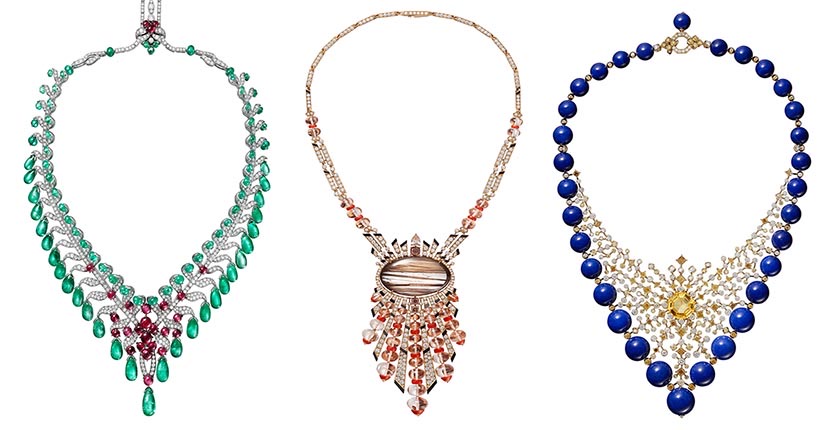
Necklaces from Cartier’s 2019 Magnitude High Jewelry Collection. Photo courtesy
Jewelry News
Necklaces Shine in Cartier’s New High Jewelry
The 2019 Magnitude collection is filled with megawatt statement jewels
Cartier is in full command. The French jeweler has a unique way of acknowledging its history and moving boldly forward. Before I get to that idea as it relates to the new 2019 Magnitude High Jewelry collection, let’s take a short walk back to a couple of months ago.
On March 22, 2019, The New York Times published an interview with the Cartier’s CEO Cyrille Vigneron reviewing the international success the firm is enjoying now. It covered how the company has adapted to global markets in ways that extend from social media savvy to producing various goods for luxury shoppers with a variety of tastes. Ultimately, Mr. Vigernon acknowledged the bottom line was linked to a brand’s history. “You cannot have any confusion about who you are or where you need to be,” he explained. “You must know your narrative inside out.”
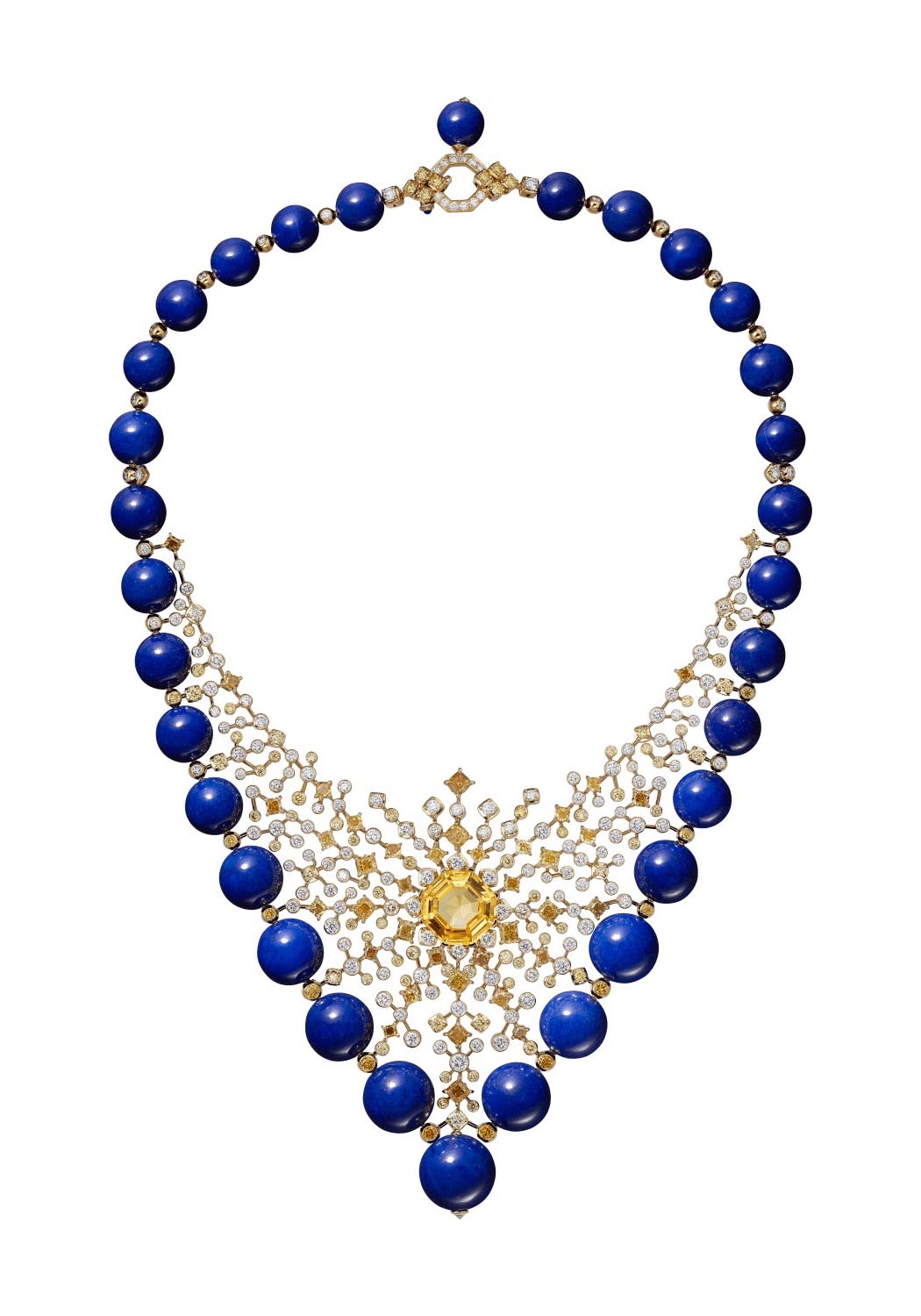
Cartier Magnitude High Jewelry necklace composed of 18K yellow gold, a 15.48-carat octagonal yellow sapphire from Ceylon, lapis lazuli beads, yellow and orange cushion-shaped diamonds, yellow, orange, and white brilliant-cut diamonds. Photo courtesy
At the 2019 Cartier High Jewelry presentation in London, there was a master class conducted by Cartier’s Style and Heritage Director, Pierre Rainero who knows the firm’s history like none other. He covered a few ways Cartier has driven High Jewelry forward in the past.
The French Maison is universally recognized as being a pioneer in fully committing to platinum as the best metal for High Jewelry at the turn of the twentieth century and turning away from the silver topped gold that had been used in diamond jewels. The King of Metals allowed Cartier to finesse all kinds of detail work in the designs and the world followed suit.
At the pre-dawn of the Art Deco era, it is believed Cartier invented the baguette shape diamond around 1912. The gem shape became a core building block of the geometric jewelry style. Pierre explained how platinum and the baguette shaped diamonds helped achieved Cartier’s eternal goal of playing with the light in jewels.
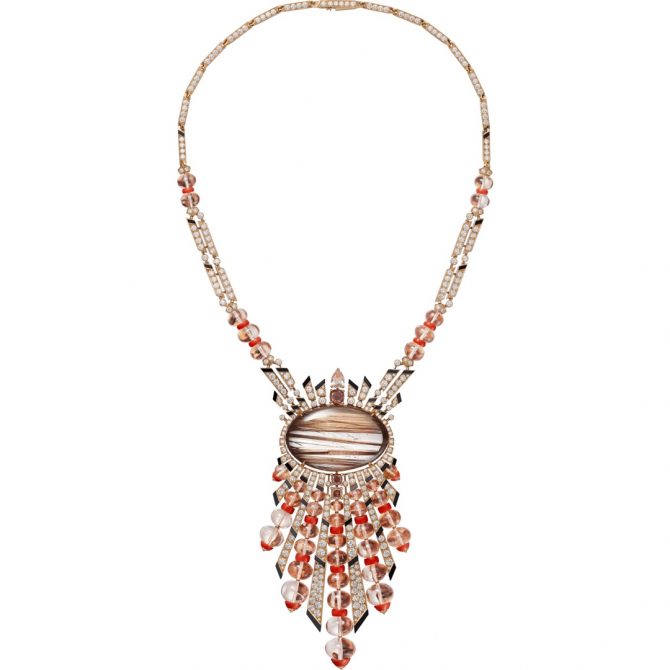
Cartier Magnitude High Jewelry necklace composed of 18K rose gold, a 68.85-carat cabochon-cut rutilated quartz, a 0.74-carat fancy brown-pink pear-shaped diamond, a 1.01-carat fancy deep brownish orangey pink cushion-shaped diamond, a 0.53-carat fancy brown-pink cushion-shaped diamond, a 0.50-carat fancy deep orangey pink cushion-shaped diamond, morganite beads, coral, onyx, brilliant-cut diamonds. Photo courtesy
Flash forward to now and Cartier still searches for its best light. The new Magnitude collection does so with an array of colorful precious and semiprecious stones. The contrast of the most precious gems with semiprecious stones is intended to be somewhat startling. Pierre went so far as to call the original color combinations “violent contrasts.”
It’s the kind of jolt of the new that has long made Cartier’s jewels stand out. Humble rutilated quartz, dreamy opals and magical lapis lazuli mixed up with diamonds, emeralds and other fancy gems are the jewelry equivalent of the high-low blend seen in Couture clothes with streetwear motifs.
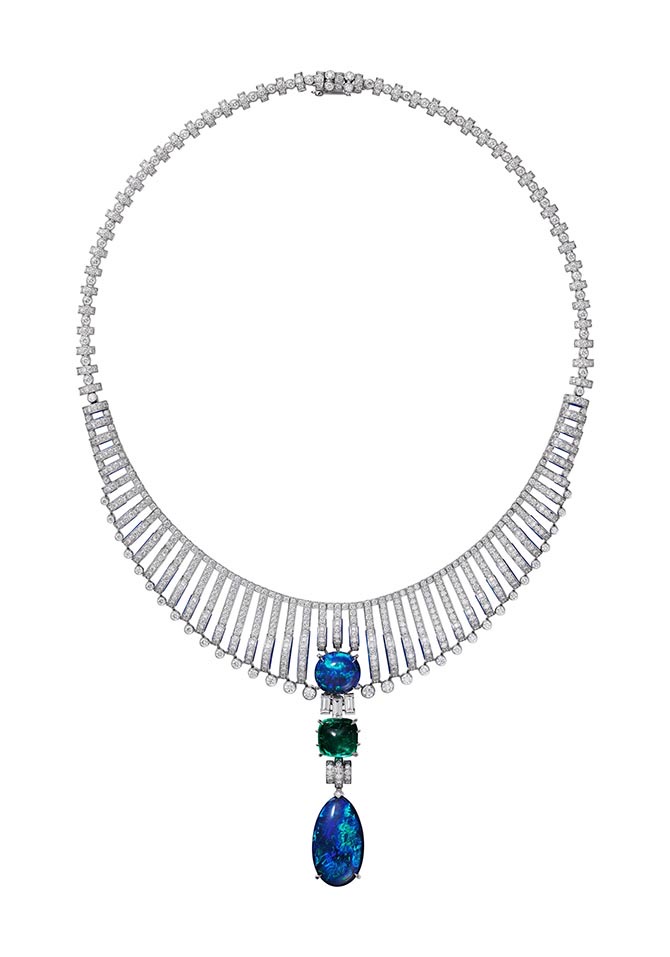
Cartier Magnitude High Jewelry transformable pendant necklace composed of 18K white gold, one 5.32- carat sugarloaf emerald from Colombia, two cabochon-cut black opals from Australia totaling 25.24-carats, lapis lazuli, baguette-cut diamonds, brilliant-cut diamonds. The pendant can be removed and worn as a brooch. Photo courtesy
“Gems hold the memory of the planet,” Pierre poetically explained. Cartier, and indeed all jewelry designers, are linked to the production of Mother Earth. In other words, the semiprecious stones in the collection are some of the most stunning stones the High Jewelry designers found on the market during their search for materials in advance of creating the collection. The production is a long game. The talents on the team begin well over a year in advance of the debut. They generally create between 100 to 200 pieces.
While the overarching theme of the Magnitude collection shown this year, and indeed the Coloratura collection last year, has been about the gemstones there are always links in the jewels to the firm’s glory years between the two World Wars when the Cartier brothers Louis, Pierre and Jacques ran the three flagships in Paris, London and New York.
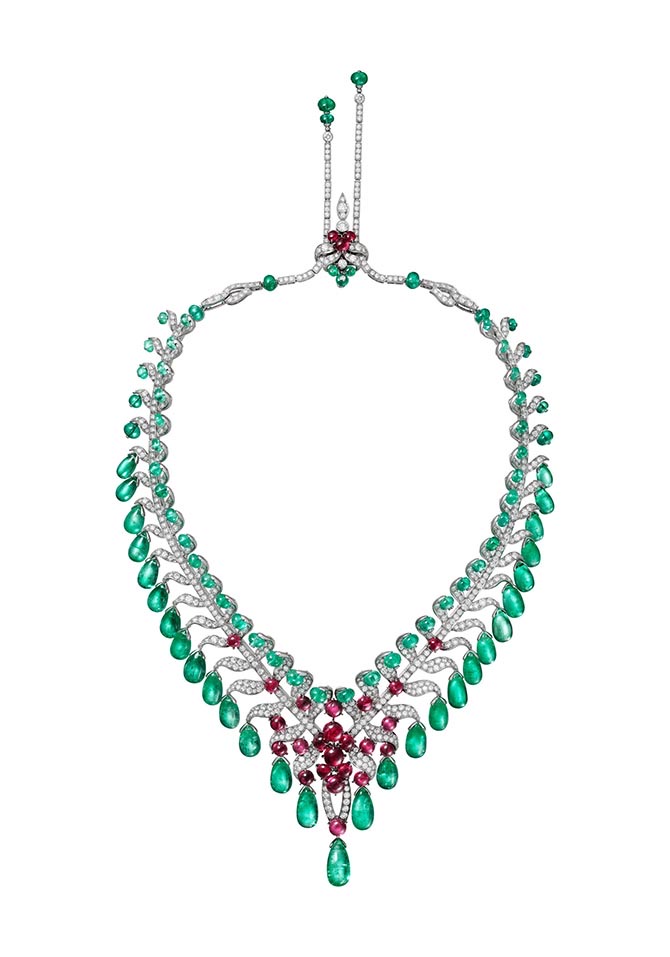
Cartier Magnitude High Jewelry necklace composed of platinum, 29 emerald drops from Afghanistan totaling 124.05-carats, emerald beads, cabochon-cut rubies, brilliant-cut diamonds. Photo courtesy
The blues and greens in the lapis, emerald and opal on one necklace reflect the Islamic art Louis Cartier loved. A passion for Indian Mughal jewelry comes shining through in the tassels here and there on designs as well as the beads and movement in certain pieces. There are Art Deco details in the geometry and silhouettes from the 1930s reimagined in modern ways.
Yet with all the history that could be found in the jewels, there was a distinctive 21st century vibe to the Magnitude designs beyond the mix of gems. Among the scores of powerful pieces, the necklaces in particular stood out as something special and fresh. Confidence beamed from the rays of gems on several necklaces. The discs sliced in half and set on their sides in some pieces felt like a new jewelry form for the Digital Age. In all, the collection proved, as Cyrille Vigneron explained, Cartier has complete understanding of its jewelry history and knowledge that one of the most important parts of the legacy is the ability to push the narrative seamlessly on to the next chapter.
Related Stories:
Cartier Jewelry In ‘The Great Gatsby’ (1974)
How I Knew Meghan Markle Would Wear Cartier On Her Wedding Day
Get a gem in your mailbox SIGN UP FOR THE ADVENTURINE NEWSLETTER




